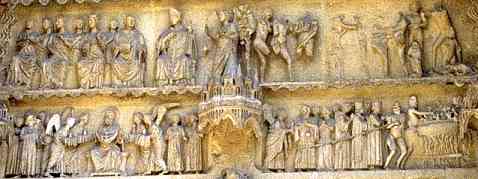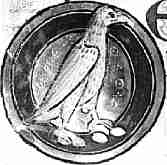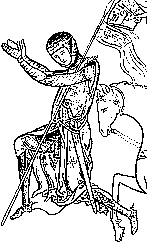 |
|
Moral
Instruction |
|
This
is not a coherent category, as moral instruction was a function of many
types of medieval works. Moral instruction was also significant in the
aural and visual culture of the era. The ultimate source of moral instruction
was the Bible, but
ordinary lay people did not, on the whole, possess one of these. The moral
messages of the Bible were translated to them through the preachings of
the clergy and through the paintings, carvings and stained glass of the
churches where they worshipped. Moral messages were encoded in the depiction
of Biblical stories, in the depiction of the virtues of the saints and
in straightforward didactic imagery. The Virtues and the Vices, or the
Seven Deadly Sins, adorned walls and pews. Representations of the Last
Judgement on the tympana of the entrance portals of major churches in
France, or painted above the chancel arch in English parish churches,
not only focused the mind on the perils of the hereafter but depicted
very literal and appropriate punishments for certain classes of sins. |
 |
15th century stained glass panel in the church of All Saints, North Street,
York. |
| This panel is one of a series representing the Corporal Acts of Mercy, derived from Christ's charges to his apostles. The smug looking figure who appears in all the panels is here visiting prisoners in the stocks. |
A carved label stop in Beverley Minster. |
|
| |
|
Two
chatting women are carried off in a cloth by a demonic figure; a warning on the evils of gossiping. |
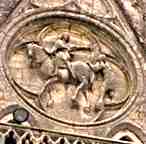 |
|
|
|
|
St
Martin divides his cloak with a beggar on the west facade of the church of
St Martin in Laon. |
|
|
The
virtuous are led to heaven by angels while the wicked are dragged off to hell
by horrible little demons in a Last Judgement scene on a tympanum in Rheims
Cathedral. |
|
The
clergy had a pile of literature on the subject, for their own moral improvement
and to help them in teaching the laity. The Bible itself, the lives of
saints, the homilies of the fathers of the church, the writings of reformers
and philosophers all had their moral dimension. Books of readings and
guides to preaching helped them guide the illiterate. The monastic rules,
such as the Rule
of St Benedict, and the various reforms built upon it, were guides
to living a moral as well as spiritually uplifting life. |
|
The
thread of moral instruction ran through many works, including those of
knowledge. The modern scientist's excuse that all knowledge is good and
they are not responsible for any evil uses made of it is a long way from
the mental template of the middle ages. The quaint and delightful compilations
known as the bestiaries
which evolved around the 12th and 13th centuries from a range of earlier
sources put the characteristics of various animals, real, fictitious and
confused, into a moral context. The great encyclopedias of the later middle
ages were threaded through with moral philosophy. |
|
|
This
illustration of a partridge from a 12th century bestiary (British Library,
Royal 12 c XIV, f.52v) accompanies a description of its fraudulent habit of
stealing each other's eggs. By permission of the British Library. |
|
|
These
were part of the Latin literature which is presumed to be for the use of the
clergy. The new forms of literature which appealed to the increasingly literate
laity in the later middle ages were infused with moral teaching, even as they
entertained and delighted. |
|
Romances
drew their themes from the concept of chivalry, based in the idea that
the active life in the service of Christian ideals was one of high morality.
In other words, it was alright, noble and proper even, to kill people
if you had God on your side. The chivalric knight was supposed to be pious,
morally upright, sexually polite and well behaved. Tales and legends from
the past became infused with moral overtones. There was treachery and
lust and all kinds of entertaining themes, but the reader had no trouble
in differentiating the traitors and lechers from the moral heroes. |
|
|
Poetry
and plays had moral themes, and of course theatrical performance was as
much about aural and visual culture as it was about the written word used
to preserve it. The crowds who tramped about York or Chester following
the progress of the Mystery
Plays were receiving their religious and moral instruction in the
context of a good day out. |
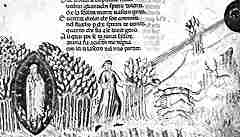 |
The
vernacular
literature of the later middle ages entertained as well as instructed.
Social criticism and satire, such as produced in Chaucer's Canterbury
Tales, has morality as a basis even when framed in tales of naughty frolics.
Then there was a fellow called Dante who wrote an amazing ripping yarn,
in meticulous Italian poetry, of a startling journey which encompassed
the pits of hell and the heights of heaven and all points in between,
carefully explaining among the gruesome or ecstatic details just why each
soul was residing where they were.
|
|
In
the middle of his life, Dante gets lost in a dark wood, meets three beasts
who block his way, has an anxiety attack, meets a dead poet and sets off to
find out what it's all about. From a 14th century Italian manuscript (British
Library, add. ms. 19587), by permission of the British Library. |
|
|
It
is intriguing that the most popular manuscript
book of the later middle ages for the laity, the book
of hours, was not fundamentally a book of moral instruction. It was
a book of spirituality and an aid to communication with higher things
without the mediation of clergy. That is what they felt they were lacking.
They had been surrounded by moral instruction for centuries. |
 Categories
of Works Categories
of Works |
|
 |
 |
 |
 |
 |
 |
 |
 |



